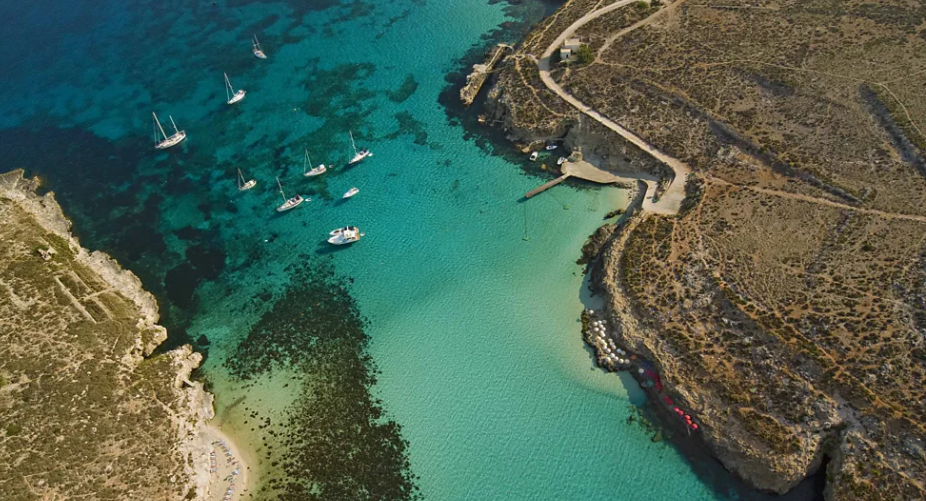The Changing Face of Comino
Once a secluded paradise, Comino has undergone a dramatic transformation. Those who visited decades ago remember a peaceful, untouched haven—an island where the only sounds were the lapping waves and the occasional cry of a seabird. Today, however, it tells a different story.
“I first visited in 1980. Back then, you could have the whole place to yourself,” recalls long-time visitor Backhouse. “Unfortunately, I’ve seen first-hand the destruction over the decades. I really don’t know why people bother anymore.”
Backhouse is not alone in his disillusionment. Frustration over Comino’s overtourism has been mounting for years, with some visitors going as far as to label the day-trip experience from Malta a “scam.” Overcrowded boats, scarce amenities, and severe environmental degradation have left many disappointed.
The Rise of Overtourism on Comino
So, what happened? How did this once-pristine island become overrun with tourists? The answer lies in its breathtaking Blue Lagoon—a stretch of iridescent turquoise water that looks straight out of a fantasy novel. This natural wonder has long been a coveted destination, but its popularity skyrocketed with the advent of social media. Travelers from around the world, eager to capture the perfect Instagram shot, flocked to Comino in ever-growing numbers.
Hollywood also played a role in putting Comino on the map. Blockbuster films and series, including The Count of Monte Cristo, Troy, and even Game of Thrones, used the island as a stunning backdrop. But while these cinematic moments showcased Comino’s beauty, they also contributed to its overexposure.
According to Rebecca Millo, head of commercial operations at KM Malta, “It’s at the top of many visitors’ bucket lists when they come to the Maltese islands. Many people just want to go straight there.”
The Consequences of Unchecked Tourism
The surge in tourism has taken a toll on Comino’s delicate ecosystem. Boats packed with eager visitors spill onto the island daily, bringing noise, pollution, and litter. The once-serene beaches are now lined with deckchairs and sunbeds, many of which have been privatized—restricting public access to spaces that were once free for all to enjoy.
Local activists have had enough. In 2022, a group called Movimenti Graffiti took matters into their own hands by removing the deckchairs and sunbeds, protesting what they saw as the exploitation of public land for private profit. Their message was clear: Comino should be preserved, not plundered.

A Step Towards Sustainable Tourism
Change, however, is finally on the horizon. In an effort to curb mass tourism and relieve pressure on the island—designated as a Natura 2000 site—Maltese authorities have introduced a daily visitor cap. Tour boat day-trippers will now be reduced from 10,000 to 5,000.
It’s a step in the right direction, but environmental advocates like Mark Sultana, CEO of BirdLife Malta, believe it’s only a partial fix.
“Limiting numbers is a good start,” he says. “But we need a public sustainability plan that doesn’t just focus on crowd control but also on preserving Comino’s fragile ecosystem. We are insisting it should have a ticket control system where only a capped number of tickets can be issued each day.”
The Broader Impact: Overtourism Across the Mediterranean
Comino’s struggle is part of a larger trend across the Mediterranean. Popular destinations are taking drastic measures to curb the negative effects of mass tourism:
Venice, Italy: Has introduced entry fees for day-trippers to manage crowds and preserve the city’s historic sites.
Athens, Greece: Has implemented a cap on daily visitors to the Acropolis to prevent overcrowding and degradation.
Barcelona, Spain: Continues to crack down on short-term rentals and regulate tourist numbers to protect its residents and infrastructure.
These initiatives reflect a growing recognition that unchecked tourism can have long-term consequences, not just for the environment but also for local communities.
Tourist Expectations vs. Reality
Seasoned Malta tour guide Joanne Gatt has heard the same complaints time and time again from disappointed travelers: Comino isn’t what they expected.
“They go to Comino expecting paradise and leave disappointed,” she says. “Overcrowded, chaotic. Hopefully, the cap on visitors will make a real difference.”
Many tourists arrive envisioning a peaceful retreat but are instead met with packed beaches, overpriced amenities, and a struggle for space. The contrast between expectation and reality has led to frustration, with some even vowing never to return.
The Future of Comino: Can It Be Saved?
With new regulations in place, the hope is that Comino can reclaim some of its lost charm. A reduced number of visitors should, in theory, lead to a better experience for those who do visit while allowing the island’s ecosystem a chance to recover.
However, some argue that the damage may already be irreversible. “With so many people wearing it down year after year, I just hope there’s something left for future generations to enjoy,” reflects Gatt.
Ultimately, the fate of Comino depends on a delicate balance between tourism and conservation. Will this Mediterranean gem be preserved for generations to come, or will it continue to succumb to the pressures of overtourism? Only time will tell, but one thing is clear: without sustainable measures, the paradise that once was Comino may be lost forever.
